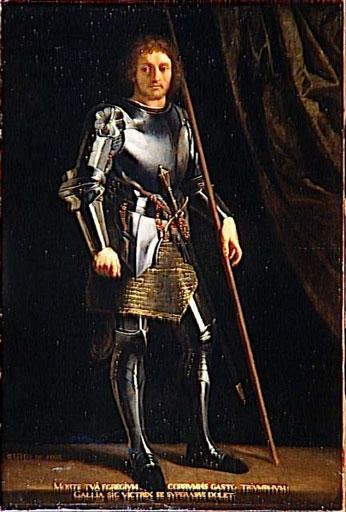Name Gaston Foix, | ||
 | ||
Parents John of Foix, Viscount of Narbonne, Marie of Orleans, Viscountess of Narbonne Grandparents Charles, Duke of Orleans, Eleanor of Navarre, Gaston IV, Count of Foix, Maria of Cleves Aunts Joan, Countess of Armagnac Similar People Germaine of Foix, Eleanor of Navarre, Pedro Navarro - Count of, Charles - Duke of Orleans, Jacques de La Palice | ||
Gaston of foix duke of nemours
Gaston de Foix, duc de Nemours (10 December 1489 – 11 April 1512), also known as The Thunderbolt of Italy, was a French military commander noted mostly for his brilliant six-month campaign from 1511 to 1512 during the War of the League of Cambrai.
Contents
Born in Mazères, County of Foix, he was the second child but only son of John of Foix, Viscount of Narbonne and Marie d'Orléans. His older sister was Germaine of Foix, Queen consort of Aragon as the second wife of Ferdinand II.
His paternal grandparents were Gaston IV of Foix-Grailly and Queen regnant Eleanor of Navarre. His maternal grandparents were Charles, Duke of Orléans and Marie of Cleves. His only maternal uncle was Louis XII of France.
Life
In 1511, Gaston arrived in Italy as a new commander at the age of 21. His presence and energy shifted the conflict into much higher levels of activity.
French forces had captured Bologna on 13 May 1511 and were under siege from a combined Papal-Spanish army commanded by Ramón de Cardona, the Viceroy of Naples. Gaston marched his army to Bologna and scattered the armies of the Holy League. He then went north and defeated the Venetians at Brescia, which the French later captured (February 1512) after a furious assault.
Gaston had established firm control over northern Italy by March 1512. He then force marched his troops south, intending to besiege Ravenna and dupe the Spanish into battle. Cardona led the Papal-Spanish forces cautiously near the French lines in order to form a strong defensive position. Gaston had about 23,000 soldiers, 8,500 of which were German landsknechte, and 54 artillery pieces. Cardona had roughly 16,000 troops and 30 artillery pieces; the garrison of Ravenna could count about 5,000 men. Gaston sent a formal invitation for battle to Cardona, who readily accepted.
The decisive Battle of Ravenna would be fought on 11 April 1512. The Spanish had their backs to the Ronco River and maintained a relatively secure front thanks to the strong entrenchments and obstacles prepared by the famous engineer Pedro Navarro. Gaston left 2,000 men to watch Ravenna and moved the rest of his force against Cardona. The French army crossed the stream between Ravenna and the Spanish camp without interference, formed in a semicircle around the enemy entrenchments, and started firing from the flanks into the Spanish position. The heavy bombardment did not trouble the well-protected Spanish infantry, but the cavalry could take no more and assaulted the French without orders. These charges were easily beaten back and the French counter-attacked. A bloody one-hour struggle ensued between the landsknechts and the Spanish in the entrenchments. At this moment, two cannons that Gaston had sent behind the Spanish lines opened fire and wrought havoc on the enemy rear. The Spanish withdrew and suffered tremendous casualties. During the pursuit, Gaston led a cavalry charge against a recalcitrant Spanish infantry unit. He was shot and killed. French casualties ran up to 9,000 while the Spanish lost nearly their entire army, as well as Pedro Navarro, who was captured.
The death of Gaston de Foix was a huge blow to the French. The young and impetuous warrior had displayed an incredible talent for high command in the recent series of French victories. It is possible that the Italian Wars would have taken a very different course had he lived.
Tomb
A very elaborate tomb was commissioned for Gaston in Milan from the workshop of Agostino Busti, which despite never being completed and assembled remains a key work in art history, and especially French Renaissance art, with (as planned) classicising relief panels of his campaigns around the base of the sarcophagus, surmounted by a more traditional recumbent effigy. Most of the pieces are on display in the Castello Sforzesco.
